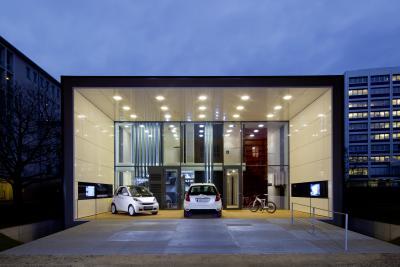 |
Daimler provides three electric vehicles with batterie electric drive as part of the German Federal Ministry of Transport, Building and Urban Development sponsored project “Effizienzhaus-Plus mit Elektromobilität”.
From March 2012, a Mercedes-Benz A-Class E-CELL, a second generation smart fortwo electric drive and a smart ebike are available for the inhabitants of the house.
Courtesy of Daimler AG |
| |
• Project "Effizienzhaus-Plus mit Elektromobilität" combines zero-emission living and driving in Berlin
• Daimler is first automotive partner to provide three electric vehicles for the project sponsored by the Federal Ministry of Transport, Building and Urban Affairs
Berlin, Germany - December 07, 2011
Charging electric cars without an electric cable – how does that work?
Daimler AG is about to test inductive charging for the first time on a vehicle in everyday use in the form of a technically modified Mercedes-Benz A-Class E-CELL.
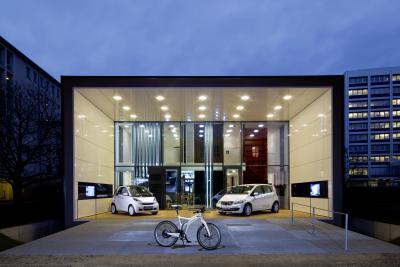 |
Daimler provides three electric vehicles with batterie electric drive as part of the German Federal Ministry of Transport, Building and Urban Development sponsored project “Effizienzhaus-Plus mit Elektromobilität”.
From March 2012, a Mercedes-Benz A-Class E-CELL, a second generation smart fortwo electric drive and a smart ebike are available for the inhabitants of the house.
Courtesy of Daimler AG |
| |
With the inductive charging principle, an electric car fitted with a special charging coil merely has to be positioned over a charging coil in the ground to start the charging process fully automatically, with no need for cable contact.
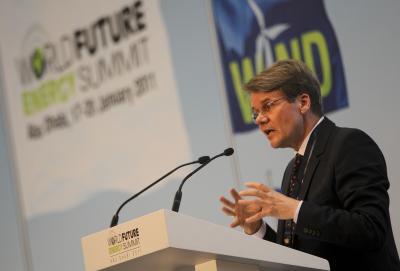 |
|
Prof. Dr. Herbert Kohler, Vice President e-drive & Future Mobility in Group Research & Advanced Engineering and Chief Environmental Officer of Daimler AG.
Courtesy of Daimler AG |
| |
"We are keen to find out how the inductive charging process proves in daily use," says
Herbert Kohler, head of e-drive & future mobility in the Research and Advance Development department at Daimler AG.
"We have already demonstrated the essential feasibility of the technology. The experience in day-to-day use will now provide important pointers for the further course of development. A number of technical and financial issues also need to be resolved before we can really assess the marketability of this technology."
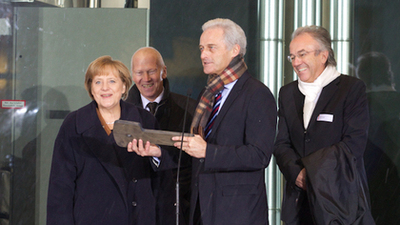 |
|
Federal Chancellor Dr Angela Merkel and Federal Minister Dr Peter Ramsauer open energy efficiency house in Berlin. December 07, 2011.
Courtesy of the Federal Ministry of Transport, Building and Urban Development, Germany (BMVBS) |
| |
The electric car will be deployed from March 2012 in the project "Effizienzhaus-Plus mit Elektromobilität", which was inaugurated in
Berlin today by
Federal Chancellor Dr. Angela Merkel and
Dr. Peter Ramsauer, Member of the Bundestag and Federal Minister of Transport, Building and Urban Affairs.
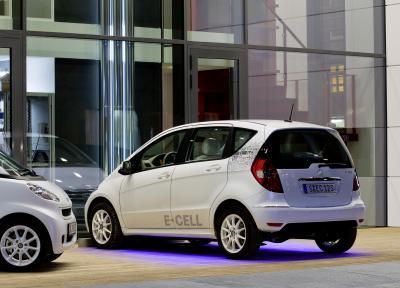 |
Effizienzhaus-Plus mit Elektromobilität: A display in the COMAND screen helps the driver of the Mercedes-Benz A-Class E-CELL to position the vehicle correctly above the loading coil for the inductive load.
Courtesy of Daimler AG |
| |
Through the application of cutting-edge technologies, the
energy-efficient house in this pilot project is intended to generate more electricity than it consumes.
This surplus electricity can be used to
recharge battery-powered electric vehicles, for example –
the home as a personal filling station.
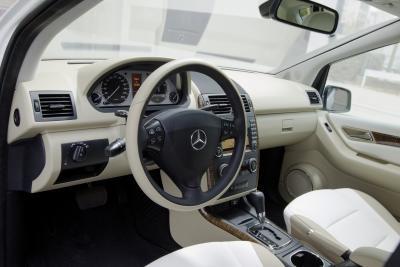 |
Effizienzhaus-Plus mit Elektromobilität: Mercedes-Benz A-Class E-CELL.
Courtesy of Daimler AG |
| |
The entire building has been designed along energy-efficient lines, seamlessly incorporating the area of
electric mobility.
Both the inductive and the
cable-based charging devices are
harmonically integrated in the house's architecture, for example.
A family of four will live at the house on an experimental basis for 15 months, beginning in March 2012.
 |
Effizienzhaus-Plus mit Elektromobilität: Second generation smart fortwo electric drive.
Courtesy of Daimler AG |
| |
During their stay at the
house they will
use various electric vehicles to explore and demonstrate how a
new generation of buildings and electric mobility interact in daily life.
Apart from the
Mercedes-Benz A-Class E-CELL with inductive charging option, Daimler AG will be providing the
"Effizienzhaus-Plus mit Elektromobilität" project from the start in
March 2012 with two other battery-powered electric vehicles for around three months: the
second-generation smart fortwo electric drive and the smart ebike.
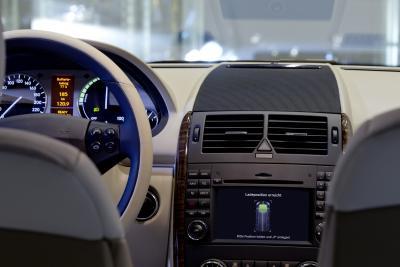 |
Effizienzhaus-Plus mit Elektromobilität: A display in the COMAND screen helps the driver of the Mercedes-Benz A-Class E-CELL to position the vehicle correctly above the loading coil for the inductive load.
Courtesy of Daimler AG |
| |
The family will thus have a
broad spectrum of battery-powered local emission-free electric vehicles from Daimler at its disposal to cover the most diverse uses.
From the two-seater tailored perfectly to urban needs through the
5-seater family car to the electric bike which opens the door to
electric mobility without any need for a driving licence.
Daimler will also attend to installation of the necessary charging infrastructure at the house, providing a wallbox for conductive charging with a cable and a charging coil for inductive charging in the carport.
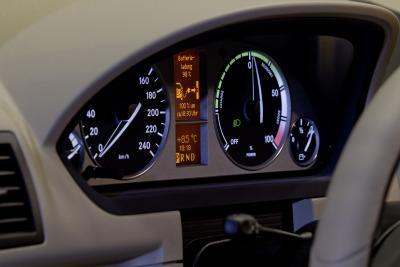 |
Effizienzhaus-Plus mit Elektromobilität: Mercedes-Benz A-Class E-CELL.
Courtesy of Daimler AG |
| |
Alternatively, the
family will also be able to charge all the vehicles at public charging stations or by plugging them into a
standard domestic power outlet.
The project "Effizienzhaus-Plus mit Elektromobilität" will show that sustainable living and driving is possible without compromising on one's
quality of life.
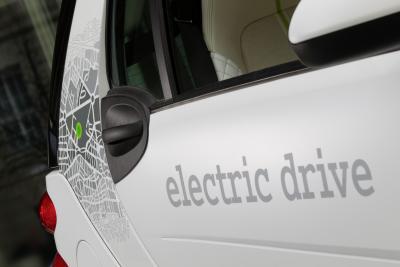 |
Effizienzhaus-Plus mit Elektromobilität: Second generation smart fortwo electric drive.
Courtesy of Daimler AG |
| |
Scientific evaluation of the data on usage of the vehicle which are collected in the course of the project may additionally provide important insights into customers' wishes – and show how electric cars can become yet more sustainable and at the same time more comfortable and convenient in the future.
Charging without a cable
In addition to charging with a cable, the
Mercedes-Benz A-Class E-CELL to be deployed in this project can also be charged inductively.
This involves non-contact transmission of the charging current by means of an electromagnetic field.
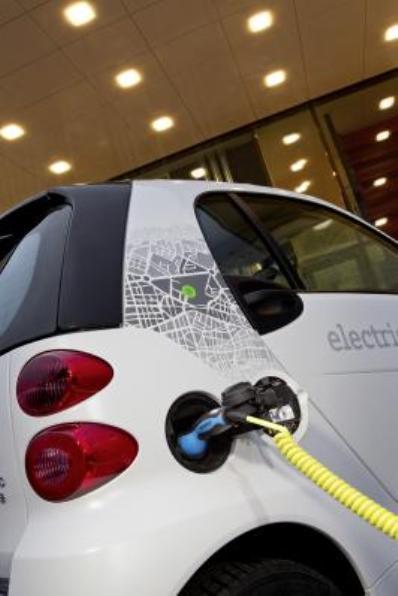 |
Effizienzhaus-Plus mit Elektromobilität: Second generation smart fortwo electric drive.
Courtesy of Daimler AG |
| |
For this purpose,
both the vehicle and the parking space at the energy-efficient house are fitted with corresponding coils.
A special display system helps the driver to manoeuvre the vehicle into the ideal position over the charging coil.
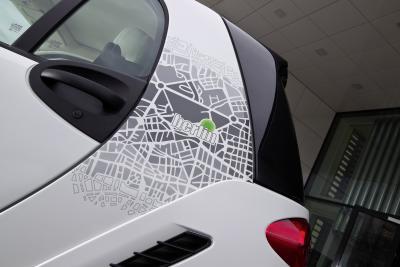 |
Effizienzhaus-Plus mit Elektromobilität: Second generation smart fortwo electric drive.
Courtesy of Daimler AG |
| |
In cooperation with
Conductix-Wampfler and
Röchling Automotive KG,
Daimler has already developed a prototype version of this technology and demonstrated its functional effectiveness in a project sponsored by the
Federal Ministry of the Environment.
The technology's suitability for everyday use is now to be sounded out thoroughly in the course of the practical trial.
A perfect match: energy-efficient house and electric vehicle in coordinated design
In order to highlight the
close functional relationship between house and vehicle, a special edition has been developed for the
"Effizienzhaus-Plus" project in close consultation between the
Mercedes-Benz Design department and "Effizienzhaus-Plus" architect Prof. Werner Sobek.
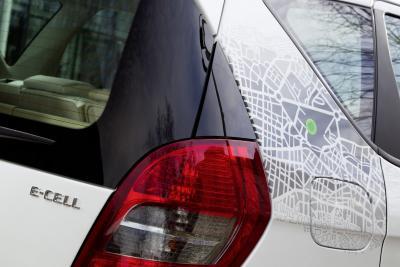 |
Effizienzhaus-Plus mit Elektromobilität: Mercedes-Benz A-Class E-CELL.
Courtesy of Daimler AG |
| |
In keeping with the design and colour concept for the house, white and natural tones are predominant in the
exterior and
interior design of the
Mercedes-Benz A-Class E-CELL and the
second-generation smart fortwo electric drive.
A specially developed pearl coat in platinum white metallic lends the vehicles a strong presence and reflects heat, thereby helping to keep the interior cool.
The combined use of
natural textiles such as
wool, linen and
nappa leather provides for an attractive contrast.
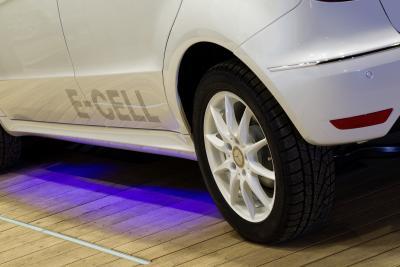 |
Effizienzhaus-Plus mit Elektromobilität: A display in the COMAND screen helps the driver of the Mercedes-Benz A-Class E-CELL to position the vehicle correctly above the loading coil for the inductive load.
Courtesy of Daimler AG |
| |
The coordinated design means that the family will feel totally at home in the cars, thus communicating the
concept of integrated sustainable home living and
motoring on a visual and
an emotional level.
Further information about the project is available online:
www.bmvbs.de/effizienzhausplus
Media Contact
Matthias Brock
Research & Development Communications
Phone: +49 (0)711 17 91404
Fax: +49 (0)711 17 94365
Madeleine Herdlitschka
Research, Development and Environmental Communications
Phone: +49 711 17 76409
Fax: +49 711 17 94365
Source: Daimler AG
http://media.daimler.com/
ASTROMAN Magazine - 2011.11.26
Daimler Invests more than EUR 1.5 Billion at its Main Mercedes-Benz Powertrain Plant in Germany
http://www.astroman.com.pl/index.php?mod=magazine&a=read&id=1108
ASTROMAN Magazine - 2011.11.19
Qualcomm: First Electric Vehicle Wireless Charging Trial Announced for London
http://www.astroman.com.pl/index.php?mod=magazine&a=read&id=1102
ASTROMAN Magazine - 2011.05.03
The Mercedes Concept A-Class at the "Auto Shanghai 2011" show
http://www.astroman.com.pl/index.php?mod=magazine&a=read&id=963

